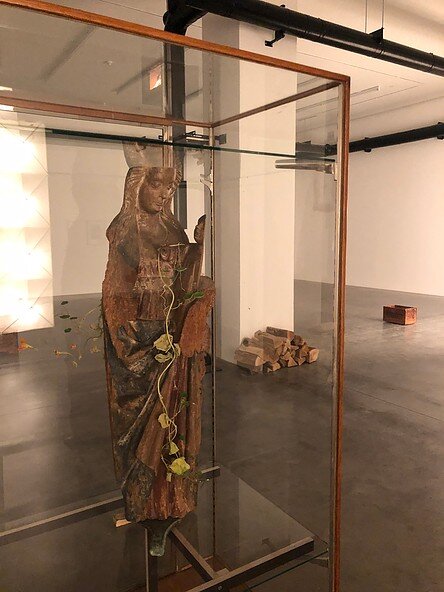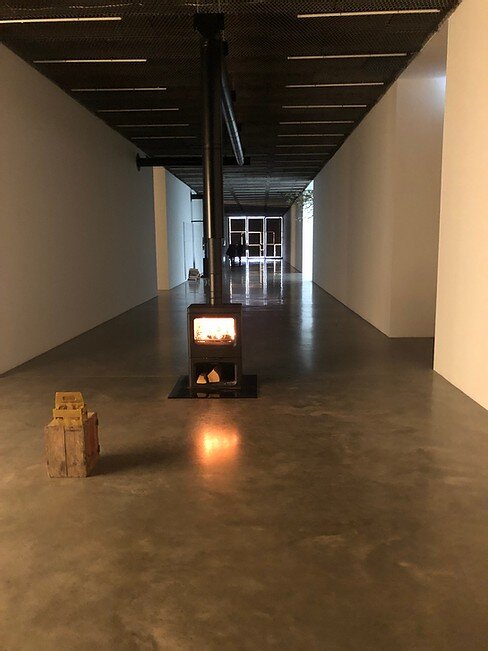The Devil’s Tail
A Review of the contemporary artist, Danh Vo's Chicxulub exhibition recently on at White Cube - Bermondsey (11 September – 2 November 2020).
White Cube featuring Chixulub by Danh Vo.
Prior to the second lockdown of 2020 in England, the work of Danish-Vietnamese artist, Danh Vo, was exhibited at the massive White Cube art complex located South of the Thames.
Throughout the course of his career, Vo has often explored heritage, culture and politics in an effort to illuminate the dichotomy of individual and shared history. His focus can largely be ascribed to his personal history, when as a child, he and his family were forced to flee Vietnam for Denmark. The emotional complexities that arose from such an upheaval and the attempt to assimilate to European culture provided Vo ample inspiration for his artworks. Found objects, like photographs and historic documentation, are an integral aspect of his practice. Such media demonstrates the effect context plays on the understanding and interpretation of art. While he compiles “ready-mades” to express his own agenda, the “objects ... retain the sublimated desire and sadness of individuals and entire cultures” under which they were initially conceived. [1]
White Cube featuring Chixulub by Danh Vo.
Danh Vo now lives and works on a farm in Germany, where he contrived Chicxulub. The title, which translates from the Yucatec Maya language to mean “the devil's tail,” may reference the famous Chicxulub impactor, as in the asteroid accredited for the extinction of the dinosaurs 66 million years ago. This allusion recalls the butterfly effect that a single event has on the course of history - from asteroid, to extinction, to the introduction of new life forms (please excuse the wealth of omitted intermediary phases). In effect, this parallels the events of the artist's life (or any life really, but for the sake of argument we'll stick to Vo). The 1975 fall of Saigon to Communism eventually resulted in Vo's relocation to Denmark, which forced him to question the idea of identity, and finally this led to his artistic exploration of history from a personal and communal level. This is all to say, the title indicates the exhibition's intention to trace the effects a single idea or event can reap.
White Cube featuring Chixulub by Danh Vo.
The White Cube galleries are abounding with historical references, tracking the “rise and fall of empires” with allusions to Rome, Greece, and even America. The presence of the American flag, assembled in wooden logs, reflects the idea that one event begets another. Several furnaces dispersed throughout the galleries are kept alight with logs pulled from the flag. Piece by piece the flag becomes more tenuous. Embedded within Vo’s flag, there were initially thirteen stars, rather than fifty. This reminds viewers of the evolution of the United States from thirteen colonies to fifty states - a progression that fundamentally occurred alongside social and political change and progress. Returning to the removal of logs, the steel stars have begun to collapse to the ground. The gradually disassembled American flag suggests the fragility of empires, or in this case nations. The show closed the day before the United States election, and its timing articulated an awareness that the (then unknown) outcome of the presidential election would shape the future. In keeping with the butterfly effect, the presumed reference to the U.S. presidential debate extends beyond the effects it will have on the nation and its citizens. The portrayal of the U.S. flag in a London gallery created by a German based Vietnamese-Danish artist draws attention to the interconnected nature of humanity thanks to globalization, and it allows viewers to question the widespread ramifications of the presidential election.
White Cube featuring Chixulub by Danh Vo.
Along with political “empires,” the theme of religious empires sits at the forefront of the show. Religion is innately alluded to in the translation of the exhibition title, regarding the term “devil.” Moreover, the stained glass and religious iconography are none too subtle references to Catholicism. Vo has previously explored the contradictory nature of religion, which often preaches peace and goodness, while simultaneously serving as the basis for many a war throughout history. Presently, however, he compares the export and proliferation of religion to that of “multinational brands,”[2]. Accordingly, the audience is once again prompted to meditate on globalization, or the shared interactions and exchanges between diverse regions. The artist juxtaposes religious iconography alongside crates bearing familiar brand names of soda, liquor, and milk. The two, while seemingly dissimilar, draw parallels in their historic diffusion and adoption by people across the globe.
White Cube featuring Chixulub by Danh Vo.
In my opinion, this association between commercial products and religion can be taken further. In the spirt of the Starz television drama American Gods, globally recognized brands and commercial goods (in place of technology and media) have come to occupy a similar position of worship to that of religious figures. Consequently, they have achieved a status as contemporary gods, replacing the old traditional gods and religious icons, which are here overgrown with flora.
The White Cube exhibition guide claims the exhibition itself “is the Garden of Eden after the coming of knowledge”.[3] This reference extends beyond the ever-present flora garnishing each room of the exhibition. Tree of the Knowledge of Good and Evil is displayed in one of the galleries and the symbolism is multi-fold. In one instance, the biblical allusion is applicable to Danh Vo’s personal history, as his family was banished from Vietnam in the wake of the 1975 fall of Saigon. As such, their exile mirrors the expulsion from Eden.
White Cube featuring Chixulub by Danh Vo.
Additionally, Vo’s reflection on the rise and fall of empires confronts the best and worst of human development, or more succinctly, good and evil. Just as mankind was condemned to death after tasting the forbidden fruit, the juxtaposition of fallen empires together with the Tree of Knowledge suggests all empires are destined to end. At this point, the exhibit could be perceived as a cynical assessment of the past, present, and future, but I believe Vo’s study of events and their effects reveals optimism, hope, and potential. The Chicxulub Impactor led to the Cretaceous–Paleogene extinction event killing the majority of all life on Earth, but then permitted the evolution of humanity; the failure of empires over millennia produced war, famine and innumerable negative consequences, but also led to adaptations and advancement in the governance of societies for a higher standard of living on average. The latter acts as a macro-level example of failing upwards. Even in the face of mortality and impermanence, humanity persists and begins anew with each generation. In the same vein, empires and nations can be replaced. Ultimately, Vo demonstrates that man can and will rebuild.
White Cube featuring Chixulub by Danh Vo.
The exhibition guide also suggests the works hint at “a basic human desire to escape or perhaps retreat,” into the past.[4] While I concur that the space exudes a certain quality of “nostalgia”, I believe this is simply a product of the familiar rather than a yearning to return to any point in history to which Vo alludes.[5] The exhibition itself is quite immersive in terms of the viewer’s senses, incorporating both exteroception and smell. The aforementioned furnaces emanate a calming warmth along with the familiar and soothing scent of burning wood. Despite resulting in the demolition to the flag, the fires provide initial comfort to visitors.
The exhibition was lengthy and encompassed a wealth of subject matter to be considered. Returning to the notion that context drives an audiences’ understanding of artwork, this exhibition is sure to have elicited a myriad of conclusions unrelated or even in opposition to my own. This is solely my interpretation of the historical allusions and artwork when presented in unison. For those who missed out on visiting the exhibition in London, you can still form your own opinion by viewing the exhibition video through the White Cube website [6].
Imagery courtesy of the author.
Isabelle Barker
Contributor, MADE IN BED
[1-5] https://whitecube.com/exhibitions/exhibition/danh_vo_bermondsey_2020
[6] https://whitecube.com/channel/channel/danh_vo_bermondsey_2020








